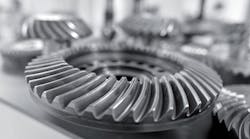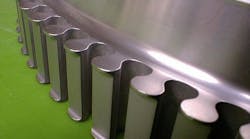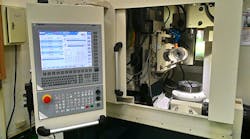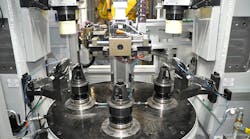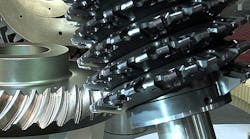High-quality gearboxes have many uses in automotive manufacturing and come in an array of configurations that make it easy to choose the perfect system for the exact needs of a given application. With so many options, it is important to know the strengths of each one, and where it may be used most effectively.
Gearboxes are single-unit solutions that manufacturers can easily plug into their power transmission systems. Inside these gearboxes, gears are ground to very tight tolerances to continuously engage with other gears without slippage. This transmits power smoothly from one gear to the next, which conserves energy within the system, and it also significantly reduces noise.
Gear ratios, which measure the input speed against the output speed, are a critical indicator of what type of gearbox is appropriate in a given application. Low gear ratios tend to transmit power more efficiently, while high gear ratios maximize torque outputs, which means they have a heavier load capacity.
Spiral bevel gearboxes — Compact spiral bevel gears have a modified curved tooth design from standard bevel gears that engages teeth more gradually than straight bevel gears with more tooth-to-tooth contact, which minimizes vibration and noise. They bring high torque and maximum efficiency to gear applications that require a high degree of reliability and variability at speeds over 1,000 rotations per minute, as is the case for vehicle differentials.
Gearboxes with spiral bevels, such as those from Eppinger, have a low tooth clearance and deliver optimal transmission via precision axes and bearing seats. Generally, these types of gearboxes have low gear ratios, ranging from 1:1 to 5:1.
Single-component steel housings for bevel gearboxes feature mounting threads on all sides to ensure stable attachment in a variety of installation positions. The heavy-duty bevel gears inside these housings offer high-transmission precision and reduced stress on the bearings. A friction-locked, zero backlash connection of the crown gears on the drive shaft reduces the mass of the gearing component. A drive-sided gearbox interface directly connects to either planetary gearbox pre-stages or motor flanges.
Hypoid gearboxes — Hypoid bevel gears are similar to spiral bevel gears in shape and application, but hypoid gear axes do not intersect with their opposing gear axes. Because hypoid gears engage multiple teeth simultaneously, they are quieter than bevel gears and decrease the load on individual teeth. Hypoid gears’ large pinion diameters deliver high torque potential and are frequently used in truck differentials.
Hypoid gear vehicle differentials frequently offset the input pinion gear to the bottom of the crown gear. This increases tooth contact and lowers the pinion drive shaft, which in turn minimizes the space the differential takes up in the vehicle’s cabin floor.
Hypoid gearboxes and two-stage hypoid spur gearboxes feature a compact, robust design suitable for both specific and highly dynamic applications. With a specially developed aluminum mono-bloc housing with high-precision bearing seats and an integrated reinforced input shank, each hypoid gearbox provides unmatched stability, accuracy and efficiency.
Two-stage, Planetary, Combinations, etc.
Two-stage hypoid spur gearboxes are composed of a variable spur gear stage along with high load capacity bevel gears that deliver smooth motions and high gear ratios, especially when compared to worm-style gearboxes. Case hardened steel in both gear stages, as is the case with Eppinger’s gearboxes, consistently minimizes torsional backlash.
Planetary gearboxes — In a planetary gear configuration, planet gears rotate on axes that revolve around a central sun gear that spins in place, while an outer fixed ring gear holds the planet gears in place. Planetary gear systems transfer torque in a straight line, which makes them ideal for use in power trains. Systems with higher numbers of planets bear higher load capacities with heightened torsional rigidity.
Planetary gearboxes deliver low backlash, high efficiency, shock resistance and a high-torque-to-weight ratio. With a modular design that combines ground gears and precision gear components, these gearboxes ensure performance efficiency and maximum uptime. They are also energy efficient and easily mount to a variety of motors.
Combination gearboxes — Combination gearboxes combine features of bevel gearboxes with those of planetary gearboxes to create an innovative solution for various applications. The stable housing design and hardened, super-finished gear components of these gearboxes help ensure smooth movement and constant backlash control. Eppinger’s planetary bevel gearboxes are efficient and achieve high-output torque and extremely high gear ratios up to i = 320:1.
Cycloidal gearboxes — Cycloidal gears transmit power between a driving shaft and driven shaft. Because they do not have straight-edged teeth, they can be difficult to accurately machine. Due to cycloidal gears’ unique shape, they do not rotate driven shafts at an even rate, which works well for slow-rotating, heavy-duty transmissions.
Compact, high-transmission cycloidal gearboxes are an excellent choice for tool machinery, automation and robotics. With integrated support bearings and a high-overload capacity, they excel in applications that require the utmost stiffness, performance, efficiency and reliability.
Custom gear-making —In terms of custom gear-making services, Eppinger, with more than 20 years of experience, can develop and manufacture virtually any type of gear. The crown gear diameters can range from 0.4 mm to 330 mm, depending on the transmission ratio. Examples include professional-quality, high-performance bevel gearboxes as well as ring and pinion gear sets. In fact, the company has made gear solutions for Mercedes, Bugatti and Airbus.
The company uses modern Gleason milling and grinding centers to machine its gears from a wide variety of workpiece materials. Gleason and Zeiss measuring machines along with Gleason test equipment ensure each gear complies with the quality requirements of DIN 3965 and American Gear Manufacturers Association (AGMA) at all times.
Eppinger’s plethora of gearbox styles ensures an exact fit for nearly endless numbers of applications. With a little know-how on what’s available, it’s a breeze to pick the right one.
